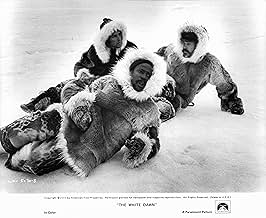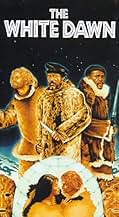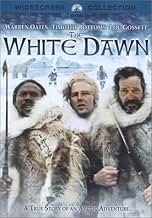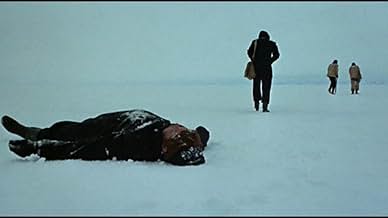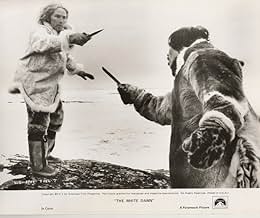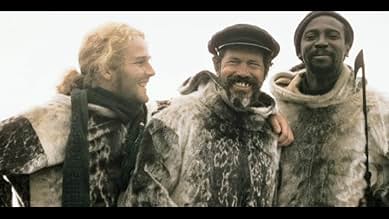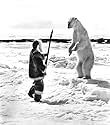En 1896, tres supervivientes de un naufragio ballenero en el Ártico canadiense son salvados y adoptados por una tribu esquimal, pero surgen fricciones cuando los tres empiezan a portarse mal... Leer todoEn 1896, tres supervivientes de un naufragio ballenero en el Ártico canadiense son salvados y adoptados por una tribu esquimal, pero surgen fricciones cuando los tres empiezan a portarse mal.En 1896, tres supervivientes de un naufragio ballenero en el Ártico canadiense son salvados y adoptados por una tribu esquimal, pero surgen fricciones cuando los tres empiezan a portarse mal.
- Dirección
- Guionistas
- Elenco
Louis Gossett Jr.
- Portagee
- (as Lou Gossett)
Ann Meekitjuk Hanson
- Neevee
- (as Pilitak)
Opiniones destacadas
It's 1896 in the Artic. Four whalers are stranded when their small hunting boat runs into ice and their ship fails to find them. Billy (Warren Oates), Daggett (Timothy Bottoms), and Portagee (Louis Gossett Jr.) leave behind their dead comrade and get rescued by passing Inuits. The Inuits see them as Dog-Children.
The Inuit culture seems authentic. There is a realism in the people and their way of life. The main drawback is the three survivors. They are not appealing characters. One of them needs to be heroic but the opening already lays bare that aspiration. Daggett and Portagee readily abandons a weaken Billy to die in the open. At least, Daggett should go back and try to comfort Billy. It's the same for their ship which searched for only a day or so for their missing crew. It portrays a western culture of personal greed and its corrupting influences. It doesn't mean that the Inuit culture is an utopian one. It is still very much a human world with its own villain. I simply didn't like the characters which detracts from my enjoyment of this film. I wish I like Daggett more.
The Inuit culture seems authentic. There is a realism in the people and their way of life. The main drawback is the three survivors. They are not appealing characters. One of them needs to be heroic but the opening already lays bare that aspiration. Daggett and Portagee readily abandons a weaken Billy to die in the open. At least, Daggett should go back and try to comfort Billy. It's the same for their ship which searched for only a day or so for their missing crew. It portrays a western culture of personal greed and its corrupting influences. It doesn't mean that the Inuit culture is an utopian one. It is still very much a human world with its own villain. I simply didn't like the characters which detracts from my enjoyment of this film. I wish I like Daggett more.
This movie contains what is surely one of the strangest, most unique, and most fascinating scenes in the history of cinematography.
The scene is of an Inuit (Eskimo) ritual. I believe it to be authentic. The screenwriter (who also wrote the original book) lived among and studied the Inuit people for decades and was probably one of the world's foremost (non-Inuit) experts on Inuit culture. Furthermore, the movie was filmed on location and using actual Inuit people as actors.
In the ritual, two girls sit cross-legged on the floor, facing each other. They seal their mouths together and take turns blowing air forcefully across the vocal cords of the other person. It creates one of the eeriest sounds I've ever heard. It's kind of a continuous huffing dronal chant, reminiscent of the background drone of bagpipes but without the shrillness. The strangest aspect of it is that there is an undertone of human voices in the sound. You get the feeling that if you listened hard enough, you could make out actual words. It is like no other sound you've ever heard - hair-raising. Who could have ever imagined that the human body could produce such a sound? Basically what they are doing is playing the other person's body like a musical instrument.
The girls continue doing this, apparently for hours, hardly stopping to take a breath. They've got to be hyperventilating, or experiencing a buildup of carbon dioxide in their lungs and blood, and it is incredible that they can go on and on like this without fainting. They must go into some kind of dizzy trance-like state.
I have never seen or heard of this ritual/technique anywhere but in this movie. I was in Alaska the summer of its Centennial year (1967) and was so fortunate to see a great many demonstrations of Inuit culture as part of the celebrations. But I didn't see anything like this, nor have I come across any description of it in my reading.
This movie would be worth seeing, preserving, and collecting on the basis of this one scene alone! (But actually the rest of it is also worth seeing.)
The scene is of an Inuit (Eskimo) ritual. I believe it to be authentic. The screenwriter (who also wrote the original book) lived among and studied the Inuit people for decades and was probably one of the world's foremost (non-Inuit) experts on Inuit culture. Furthermore, the movie was filmed on location and using actual Inuit people as actors.
In the ritual, two girls sit cross-legged on the floor, facing each other. They seal their mouths together and take turns blowing air forcefully across the vocal cords of the other person. It creates one of the eeriest sounds I've ever heard. It's kind of a continuous huffing dronal chant, reminiscent of the background drone of bagpipes but without the shrillness. The strangest aspect of it is that there is an undertone of human voices in the sound. You get the feeling that if you listened hard enough, you could make out actual words. It is like no other sound you've ever heard - hair-raising. Who could have ever imagined that the human body could produce such a sound? Basically what they are doing is playing the other person's body like a musical instrument.
The girls continue doing this, apparently for hours, hardly stopping to take a breath. They've got to be hyperventilating, or experiencing a buildup of carbon dioxide in their lungs and blood, and it is incredible that they can go on and on like this without fainting. They must go into some kind of dizzy trance-like state.
I have never seen or heard of this ritual/technique anywhere but in this movie. I was in Alaska the summer of its Centennial year (1967) and was so fortunate to see a great many demonstrations of Inuit culture as part of the celebrations. But I didn't see anything like this, nor have I come across any description of it in my reading.
This movie would be worth seeing, preserving, and collecting on the basis of this one scene alone! (But actually the rest of it is also worth seeing.)
This little-known film of Philip Kaufman's is a look at a culture not seen much in films, that of the Innuit, or Eskimo people of Arctic Canada. Three whalers (Warren Oates, Timothy Bottoms and Louis Gosset Jr.) are stranded among them after a shipwreck. The year is 1896 but it could just as well be 1996 or 1796 as far as we can tell in this simple world where survival against nature is always the biggest concern. Surprisingly to me, the culture clash does not seem to be that great through most of the movie, and when it comes, it does so rather quickly. I think this makes for a less strong film but it's still an interesting one that really fascinates at times.
Cinematographer Michael Chapman ('Raging Bull') provides some great shots of the Great White North and Henry Mancini's score is very nice also. Martin Ransohoff is usually known as a producer but co-wrote the script here with Thomas Rickman.
Cinematographer Michael Chapman ('Raging Bull') provides some great shots of the Great White North and Henry Mancini's score is very nice also. Martin Ransohoff is usually known as a producer but co-wrote the script here with Thomas Rickman.
Looking back from the 21st century, it is obvious that from the moment Columbus set foot in the new world the indigenous peoples of the Americas were doomed. It is equally obvious to a thoughtful viewer from 2005 that a movie made in 1973 about three shipwrecked whalers who are rescued by a band of Inuit and the resulting culture clash is going to end in tragedy. I knew the conclusion of "The White Dawn" as soon as I read two sentences of it's description on Netflix.
But we shouldn't really hold that against it. Because "The White Dawn" is a very good movie and I am shocked that more movie aficionados haven't heard of it. I never did, and I am a fan of Philip Kaufman and Timothy Bottoms and movies of the 70s, and I have an interest in the arctic. This movie seems to have been buried under a rock somewhere, despite fine performances all around, beautiful cinematography and direction, and fascinating subject matter in the Eskimos.
Filmed on location on Baffin Island in what is now Nunavet, the Inuit territory of Northern Canada, "The White Dawn" portrays the story of the three whalers - Timothy Bottoms, Louis Gossett Jr, and Warren Oates as they live with a sympathetic and friendly Inuit band over the course of a year, and how ultimately the interaction of the two world views leads to tragedy. It is based on the novel of the same name by James Houston, who lived with the Inuit for many years and based his novel on stories handed down through the generations of an actual event of 1897. In a fine performance, Bottoms is sensitive and open to the Eskimo way of life, falling in love with the woman Neevee. On the other hand is arrogant and exploitive Oates, who comes to represent the worst of "civilized" man's attitudes towards the Eskimo. He is dramatically counterbalanced by the equally manipulative Inuit Shaman, who pronounces that the whalers are bringing evil to the band of Eskimos.
While the ending might seem preordained, "The White Dawn" is full of texture as it examines the meeting of cultures. And beyond the story itself, it is full of vivid and powerful images of Eskimo life, presented with apparently absolute realism by the amateur (but very good) Inuit cast. The joys and sorrows of the native's communal life are conveyed as they travel and hunt through the seasons. The highlights of the movie include a seal hunt, later a more desperate walrus hunt, and a winter dance in a large igloo, featuring the strange and wonderful throat chanting of two Inuit girls.
A note for animal lovers - according to the commentary track, while seals and walruses were killed in filming, they were only killed if they would have been killed anyway, and the slain animals were completely utilized for food and fur by the Inuit (who do still hunt and rely on seals). The polar bear used in filming was not injured in any way.
If you are a fan of the cinema of the 70s or movies in general, and are willing to accept the grim nature of the story, I highly recommend "The White Dawn". Certainly it should gain a wider audience and not be forgotten.
But we shouldn't really hold that against it. Because "The White Dawn" is a very good movie and I am shocked that more movie aficionados haven't heard of it. I never did, and I am a fan of Philip Kaufman and Timothy Bottoms and movies of the 70s, and I have an interest in the arctic. This movie seems to have been buried under a rock somewhere, despite fine performances all around, beautiful cinematography and direction, and fascinating subject matter in the Eskimos.
Filmed on location on Baffin Island in what is now Nunavet, the Inuit territory of Northern Canada, "The White Dawn" portrays the story of the three whalers - Timothy Bottoms, Louis Gossett Jr, and Warren Oates as they live with a sympathetic and friendly Inuit band over the course of a year, and how ultimately the interaction of the two world views leads to tragedy. It is based on the novel of the same name by James Houston, who lived with the Inuit for many years and based his novel on stories handed down through the generations of an actual event of 1897. In a fine performance, Bottoms is sensitive and open to the Eskimo way of life, falling in love with the woman Neevee. On the other hand is arrogant and exploitive Oates, who comes to represent the worst of "civilized" man's attitudes towards the Eskimo. He is dramatically counterbalanced by the equally manipulative Inuit Shaman, who pronounces that the whalers are bringing evil to the band of Eskimos.
While the ending might seem preordained, "The White Dawn" is full of texture as it examines the meeting of cultures. And beyond the story itself, it is full of vivid and powerful images of Eskimo life, presented with apparently absolute realism by the amateur (but very good) Inuit cast. The joys and sorrows of the native's communal life are conveyed as they travel and hunt through the seasons. The highlights of the movie include a seal hunt, later a more desperate walrus hunt, and a winter dance in a large igloo, featuring the strange and wonderful throat chanting of two Inuit girls.
A note for animal lovers - according to the commentary track, while seals and walruses were killed in filming, they were only killed if they would have been killed anyway, and the slain animals were completely utilized for food and fur by the Inuit (who do still hunt and rely on seals). The polar bear used in filming was not injured in any way.
If you are a fan of the cinema of the 70s or movies in general, and are willing to accept the grim nature of the story, I highly recommend "The White Dawn". Certainly it should gain a wider audience and not be forgotten.
Philip Kaufman is a filmmaker I find fascinating, but few other people seem to share that enthusiasm (or even know who he is). He made some oddities in the 1960s and 1970s, before having an amazing streak between 1978 and 1988, directing: Invasion of the Body Snatchers (an improvement of a remake), The Wanderers (most underrated coming-of-age movie), The Right Stuff (that one's literally perfect), and then The Unbearable Lightness of Being (very different to the book, but great for different reasons). His '90s output - or at least what I've seen - is interesting, but not as impressive; movies like Henry & Jules and Quills are both boundary-pushing and a bit patience-testing.
Anyway, seeking out something that's obscure even by his standards was always going to be interesting. Enter The White Dawn, which can't really be included as part of his hot streak. It is pretty decent for what it tries to do, but it lacks a certain something. Maybe that's the point. Kaufman operates on a strange level most people don't really click with. Even I've only clicked with his stuff a handful of times. But what a handful!
The White Dawn is about three European (I think) men getting stranded in the Arctic and then rescued by an Eskimo tribe. I liked how there was subtitled language for the tribe; perhaps even more of their dialogue than English dialogue. There was also a level of respect or at least empathy that you don't always get in films of this age, dealing with some kind of cultural divide.
I guess it fell apart a bit narratively and pacing-wise. It's sort of just a slice-of-life film, at a point, and in an odd way. It continues on for a bit and then it ends, and I was fighting the urge to drift out of it. I think it falters in some areas but I appreciated the authenticity and the way it looked at a different culture of people. The authenticity also carried over to the look and feel of the film; it's an effectively chilly one.
Anyway, seeking out something that's obscure even by his standards was always going to be interesting. Enter The White Dawn, which can't really be included as part of his hot streak. It is pretty decent for what it tries to do, but it lacks a certain something. Maybe that's the point. Kaufman operates on a strange level most people don't really click with. Even I've only clicked with his stuff a handful of times. But what a handful!
The White Dawn is about three European (I think) men getting stranded in the Arctic and then rescued by an Eskimo tribe. I liked how there was subtitled language for the tribe; perhaps even more of their dialogue than English dialogue. There was also a level of respect or at least empathy that you don't always get in films of this age, dealing with some kind of cultural divide.
I guess it fell apart a bit narratively and pacing-wise. It's sort of just a slice-of-life film, at a point, and in an odd way. It continues on for a bit and then it ends, and I was fighting the urge to drift out of it. I think it falters in some areas but I appreciated the authenticity and the way it looked at a different culture of people. The authenticity also carried over to the look and feel of the film; it's an effectively chilly one.
¿Sabías que…?
- TriviaAccording to producer Irwin Winkler, this movie was the main factor in his decision to invite director Philip Kaufman to direct Los elegidos (1983). Portions of Henry Mancini's score for this film can be heard in the later film.
- Versiones alternativasThe film was originally given an "R" rating from the MPAA due to the nudity which was then edited for the film to receive a "PG" rating.
- ConexionesReferenced in Realizing 'The Right Stuff' (2003)
Selecciones populares
Inicia sesión para calificar y agrega a la lista de videos para obtener recomendaciones personalizadas
- How long is The White Dawn?Con tecnología de Alexa
Detalles
- Fecha de lanzamiento
- Países de origen
- Idioma
- También se conoce como
- Die weiße Dämmerung
- Locaciones de filmación
- Productoras
- Ver más créditos de la compañía en IMDbPro
Taquilla
- Presupuesto
- USD 1,700,000 (estimado)
Contribuir a esta página
Sugiere una edición o agrega el contenido que falta

